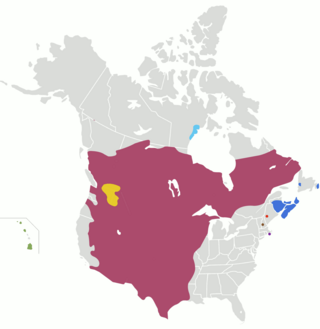
Back የሜዳ ቀይ ሕንዳውያን እጅ ምልክት ቋንቋ Amharic Мова жэстаў паўночнаамерыканскіх індзейцаў Byelorussian Znakové jazyky indiánů z Velkých plání Czech Indiana gestlingvo Esperanto Lenguaje de señas del indio de las llanuras Spanish Tasankointiaanien viittomakieli Finnish Langue des signes des Indiens des Plaines French Flakte-Yndiaanske Gebeartetaal Frisian Lingua de sinais dos indios das chairas Galician Znakovni jezik prerijskih Indijanaca Croatian
| Plains Indian Sign Language | |
|---|---|
| Hand Talk Plains Sign Language First Nation Sign Language[1] | |
| Langue des signes des Indiens des Plaines Langue des signes des autochtones des Plaines[2][3] (in French Canada) Lenguaje de signos Indio de las Llanuras (in Mexico) | |
 | |
| Native to | Canada, Mexico, USA |
| Region | Central Canada and United States including the Great Plains and the Rocky Mountains region; northern Mexico |
| Ethnicity | Various Plains Indians |
Native speakers | Unknown |
Isolate, formerly a trade pidgin | |
| Dialects |
|
| None; illustrations of signs | |
| Official status | |
Official language in | none |
Recognised minority language in | Recognised as official in courts, education and legislative assembly of Ontario.[1] |
| Language codes | |
| ISO 639-3 | psd |
| Glottolog | plai1235 |
| ELP | Plains Indian Sign Language |
 | |

Plains Indian Sign Language (PISL), also known as Hand Talk or Plains Sign Language, is an endangered[5] language common to various Plains Nations across what is now central Canada, the central and western United States and northern Mexico.[6] This sign language was used historically as a lingua franca, notably for trading among tribes; it is still used for story-telling, oratory, various ceremonies, and by deaf people for ordinary daily use.[7]
In 1885, it was estimated that there were over 110,000 "sign-talking Indians", including Blackfoot Confederacy, Cheyenne, Sioux, Kiowa and Arapaho. As a result of several factors, including the European colonization of the Americas, the number of sign talkers declined sharply from European colonization onward. However, growing interest and preservation work on Plains Sign Language has increased its use and visibility in the 21st century.[6] Historically, some have likened its more formal register, used by men, to Church Latin in function.[8] It is primarily used today by elders and deaf members of Native American tribes.[5]
Some deaf Indigenous children attend schools for the deaf and learn American Sign Language (ASL) having already acquired Plains Sign Language.[7] A group studied in 1998 were able to understand each other, though this was likely through the use of International Sign.[7] Jeffrey E. Davis, a leading linguist in documentation efforts,[5] hypothesizes that this contact, combined with potential contact with Martha's Vineyard Sign Language (another potential antecedent to ASL) may suggest that ASL descends in part from Plains Sign Language.[9]: 24–27
- ^ a b Recognition of Sign Language as an Official Language Act (Bill 273). Legislative Assembly of Ontario. 2007.
- ^ Rice, Keren (2020). "Langues des signes autochtones au Canada". In Wilson-Smith, Anthony (ed.). L’Encyclopédie canadienne (in French).
- ^ Public Services and Procurement Canada (October 27, 2020). "TERMIUM Plus®". www.btb.termiumplus.gc.ca. Government of Canada. Retrieved August 7, 2023.
- ^ "Indian Sign Language Council of 1930" – via www.youtube.com.
- ^ a b c Davis, Jeffery E. (2016). "Sign Language, Indigenous". In Gertz, Genie; Boudreault, Patrick (eds.). The SAGE Deaf Studies Encyclopedia. Vol. 1. SAGE Publications. pp. 783–786. ISBN 9781483346489.
- ^ a b Hilleary, Cecily (April 3, 2017). "Native American Hand Talkers Fight to Keep Sign Language Alive". Voice of America. Retrieved May 25, 2023.
- ^ a b c McKay-Cody, Melanie Raylene (1998). "Plains Indian Sign Language: A comparative study of alternative and primary signers". In Carroll, Cathryn (ed.). Deaf Studies V: Toward 2000—Unity and Diversity. Washington DC: Gallaudet University Press. ISBN 1893891097.
- ^ Neisser, Arden (1983). The Other Side of Silence. Gallaudet University Press. pp. 91–92. ISBN 9780930323646.
- ^ Davis, Jeffrey E. (2010), Hand talk: Sign language among American Indian nations, Cambridge UK: Cambridge University Press, ISBN 9780521690300
© MMXXIII Rich X Search. We shall prevail. All rights reserved. Rich X Search